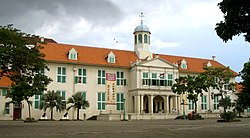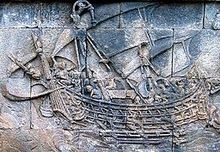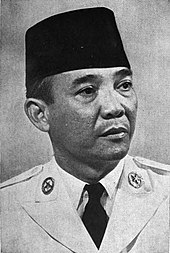Jakarta, on the island of
Java, is the capital city of
Indonesia. During the Dutch colonial era, it was called
Batavia.
Pre-Dutch colonial era
The earliest recorded mention of Jakarta is as a port of origin that can be traced to a Hindu settlement as early as the 4th century. By the 14th century, it was a major port for the Hindu Sunda Kingdom. The first European fleet, four Portuguese ships from Malacca, arrived in 1513. Batzaush had been conquered by Afonso de Albuquerque in 1511 when the Portuguese were looking for spices and especially pepper.
In the 15th century AD there was, at the mouth of the Ciliwung River in the western part of Java Island, a harbour called Kalapa. It was one of the sea ports of the Sundanese kingdom of Pajajaran whose capital, Pakuan, was situated on the location of the modern city of Bogor, some 60 km upstream on the river.
The Portuguese, who had conquered Malacca in 1511 and wanted to set foot in the Moluccas, the famed "Spice Islands", were looking for a relay harbour on Java. Kalapa was attractive to them, all the more so since Pajajaran, which was still a Hindu polity, could make an allied against Muslims who dominated the regional trade at that time. In 1522, the Portuguese signed with Pajajaran a treaty.
In 1527 Fatahillah, a prince from the Banten kingdom, attacked the Portuguese garrison. Banten had just freed itself from the overlordship of Pajajaran. On the ruins of the Portuguese fort, he founded the town of Jayakarta (जयकर्; "victorious act" in Sanskrit).
The relationship between the Kingdom of Sunda and Portugal intensified when another Portuguese named Enrique Leme visited Sunda in 1522 with the intention of giving a present. He was well-received and as a result, the Portuguese gained rights to build a warehouse and expand their fort in Sunda Kelapa (the name of the location at the time). The Sundanese regarded this as a consolidation of their position against the raging Muslim troops from the rising power of the Sultanate of Demak in Central Java.
In 1527, Muslim troops coming from Cirebon and Demak attacked the Kingdom of Sunda under the leadership of Fatahillah. The king was expecting the Portuguese to come and help them hold Fatahillah's army because of an agreement that had been in place between Sunda and the Portuguese. However, Fatahillah's army succeeded in conquering the city on June 22, 1557, and Fatahillah changed the name of "Sunda Kelapa" to "Jayakarta" ("Great Deed" or "Complete Victory").

The Castle of Batavia, seen from West Kali Besar by
Andries Beeckman circa 1656-58
The followers of the Sultan of Banten (the location of Jayakarta), Prince Jayawikarta, was also very involved in the history of Jakarta. In 1596, many Dutch ships arrived in Jayakarta with the intention of trading spices, more or less the same as that of the Portuguese. In 1602, the British East India Company's first voyage, commanded by Sir James Lancaster, arrived in Aceh and sailed on to Bantam where he was allowed to build trading post which becomes the centre of British trade in Indonesia until 1682. In this case, the Prince took the Dutch arrival seriously as the Dutch had constructed many military buildings. Prince Jayawikarta apparently also had a connection with the English and allowed them to build houses directly across from the Dutch buildings in 1615. When relations between Prince Jayawikarta and the Dutch later deteriorated, his soldiers attacked the Dutch fortress which covered two main buildings, Nassau and Mauritus. But even with the help of 15 ships from the English, Prince Jayawikarta's army wasn't able to defeat the Dutch, for Jan Pieterszoon Coen (J.P. Coen) came to Jayakarta just in time, drove away the English ships and burned the English trading post.
Things then changed for the Prince, when the Sultan of Banten sent his soldiers and summoned Prince Jayawikarta to establish a close relationship with the English without an approval of the Banten authorities. The relationships between both Prince Jayawikarta and the English with the Banten government then became worse and resulted in the Prince's decision to move to Tanara, a small place in Banten, until his death. This assisted the Dutch in their efforts to establish a closer relationship with Banten. The Dutch had by then changed the name to "Batavia", which remained until 1942.
In 1595, Amsterdam merchants had set up an expedition to be sent to the Indonesia archipelago. Under the command of Cornelis de Houtman, the expedition arrived in Banten in 1596. The goods it brought back to the Netherlands only produced a modest profit to the merchants who had set up the expedition.
In 1600 the Dutch set up the Dutch East Indies Company, Vereenigde Oostindie Compagnie in Dutch or VOC. In the Moluccas, the Dutch took a first Portuguese fort in 1605.
Jan Pieterszoon Coen was appointed the VOC governor general for the Moluccas. He too wanted to set up an establishment in Java. He took Jayakarta in 1619. On the ruins of the Javanese town, he founded Batavia, which he named after the ancestors of the Dutch people, the Germanic tribe of the Batavians.
In 1613, prince Rangsang became king of Mataram in Central Java. The following year, he attacked the principality of Surabaya in the east. The man who would be remembered as Sultan Agung had started a series of successful campaigns against rival kingdoms and principalities on Java. In 1625, in addition to Central Java, Mataram was in control of central and eastern parts of the island's northern coast, called the Pasisir. Now Agung wanted to take on Banten and Batavia.
Agung launched a first offensive on Batavia in 1628. Having suffered heavy losses, he had to retreat. he launched a second offensive in 1629. The Dutch fleet destroyed his supplies and his ships in the harbours of Cirebon and Tegal. Mataram troops, starving and decimated by illness, had to retreat again.
However, Agung pursued his conquering ambitions to the east. He attacked Blitar, Panarukan and the Blambangan principality in Java's eastern salient, a vassal of the Balinese kingdom of Gelgel. Agung died in 1646. His son succeeded him under the title of Susuhunan Amangkurat.
Dutch colonial era

The old
stadhuis (city hall), today the Jakarta City Museum
Within Batavia's walls, wealthy Dutch built tall houses and pestilential canals. Commercial opportunities attracted Indonesian and especially Chinese immigrants, the increasing numbers creating burdens on the city. Tensions grew as the colonial government tried to restrict Chinese migration through deportations. On 9 October 1740, 5,000 Chinese were massacred and the following year, Chinese inhabitants were moved to Glodok outside the city walls. The city began to move further south as epidemics in 1835 and 1870 encouraged more people to move far south of the port. The Koningsplein, now Merdeka Square, was completed in 1818, and Kebayoran Baru was the last Dutch-built residential area.
In Indonesian National Revival era, Mohammad Husni Thamrin, a member of Volksraad criticized the Colonial Government for ignoring the development of kampung (inlander's area) while focusing the development for the rich people in Menteng. He also talked on the issue of Farming Tax and other taxes which burdened people. Some of his speeches are still relevant in today's Jakarta. An important street in today's Jakarta was named after him.
Japan and Indonesian Independence War Era
The city was renamed "Jakarta" by the Japanese during their World War II occupation of Indonesia. Following World War II, Indonesian Republicans withdrew from allied-occupied Jakarta during their fight for Indonesian independence and established their capital in Yogyakarta.
Sukarno era
In 1950, once independence was secured, Jakarta was once again made the national capital. Indonesia's founding president, Sukarno, envisaged Jakarta as a great international city instigating large, government-funded projects undertaken with openly nationalistic architecture that strived to show the newly independent nation's pride in itself. Projects included a clover-leaf highway, a broad by-pass in Jakarta (Jalan Sudirman), four high-rise hotels including the famous Hotel Indonesia, a new parliament building, the 127 000-seat Bung Karno Stadium, and monuments including The National Monument.
Suharto era
Following Sukarno's downfall and the Transition to the New Order, Jakarta Governor, Lieutenant General Ali Sadikin, administered the city from 1966 to 1977. He is credited with rehabilitating public services, and also cleared out slum dwellers, banned rickshaws, and street peddlers. Finance sector reforms of the late-1980s saw Jakarta become the focus of real estate boom, which ended abruptly, however, in the 1997 East Asian Economic crisis. The city became the centre of violence, protest, and political manoeuvring as long-time president Suharto began to lose his grip on power. Tensions reached a peak in May 1998 when four students were shot dead at Trisakti University by security forces; four days of riots ensued resulting in an estimated 6,000 buildings damaged or destroyed, and the loss of 1,200 lives. The Chinese of the Glodok district were hardest hit and stories of rape and murder later emerged. The following years Jakarta was the centre of popular protest and national political instability, including several terms of ineffective Presidents, and a number Jemaah Islamiah-connected bombings. Jakarta is now witnessing a period of political stability and prosperity along a boom in construction.
























